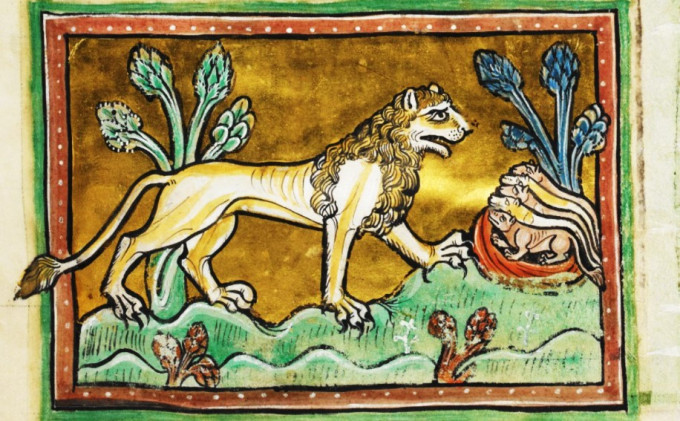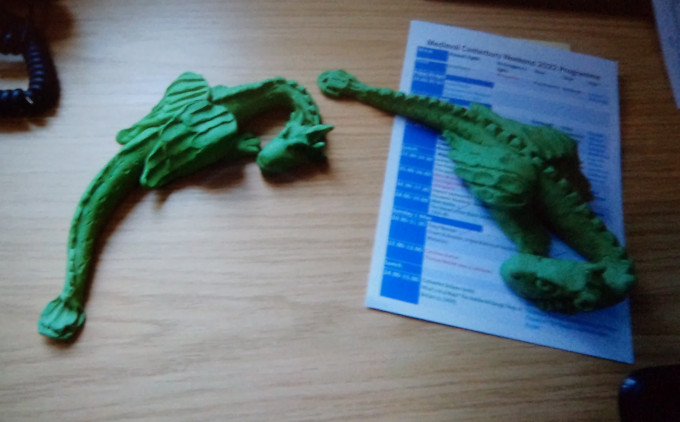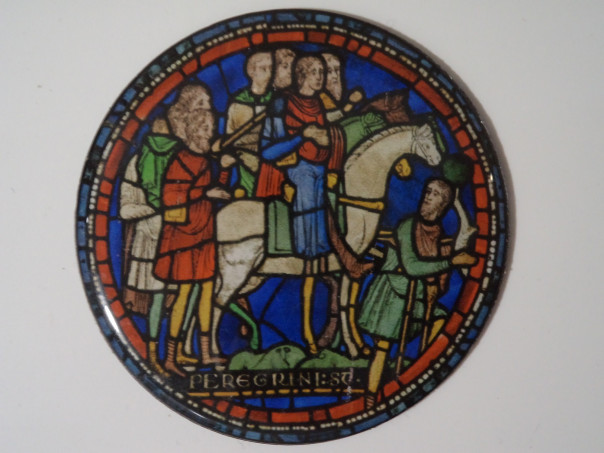Just as an alert to regular blog readers, this is the last CKHH blog until it restarts early in September. Not that this means we aren’t doing anything over August. For example, Dr Diane Heath and her ‘Medieval Animals Heritage’ team have a series of events (see below), but we need the space to do other things too.

For today, therefore, I’ll start with Diane’s exciting summer holiday programme for SEND families, and then mention an opportunity for ‘young historians’ linked to the CKHH temporary exhibition at Dover. This will go up this evening and then tomorrow evening I’ll add a report on the Eastbridge talk scheduled for tomorrow afternoon.
So to Diane, Martin Crowther and Dr Pip Gregory, firstly, there was a highly successful Medieval Mermaids event on Ramsgate beach last Sunday (23 July) where SEND families produced a series of sandcastle mermaids and mermen which they decorated with beachcombing finds. The event finished with a picnic.
Keeping with the seaside, the next event will be back on Ramsgate Main Sands beach for more ‘Medieval Mermaids sandcastle-building’ for SEND families on Wednesday 2 August between 10am and noon. Again, booking is essential and can be found at: Medieval Mermaids sandcastle-building – for SEND families Tickets, Wed 2 Aug 2023 at 10:00 | Eventbrite
Now for lovers of fossils, the team’s next event will be on the evening of Thursday 3 August (6pm to 9pm). The Prehistoric Sharks Teeth Hunt – for SEND families will involve hunting for 50-million-year-old fossil sharks’ teeth on Beltinge beach. At the same time, SEND families will discover some fabulous medieval stories about fossils. For further details and to book, please see: Prehistoric Sharks Teeth Hunt – for SEND families Tickets, Thu 3 Aug 2023 at 18:00 | Eventbrite Another treat for fossil lovers scheduled by the Medieval Animals Heritage team will take place on Tuesday 8 August between 10am and 1pm. This time the location is the beach at Folkestone Warren, a great place to find fossils. Join Diane, Martin and Pip to see if you can find amazing ammonites. These incredible creatures lived in the semi-tropical seas that covered Kent over 65 million years ago. There are medieval stories about these creatures, including the tale that St Hilda turned these serpents to stone. For more details and booking, please check out: Folkestone Fossil Foray – for SEND families Tickets, Tue, Aug 8, 2023 at 10:00 AM | Eventbrite
For something a bit different, there will be a spectacular free Dover Dinosaur Day on Wednesday 9 August between 10am and 3pm in Pencester Gardens. As Martin says, as well as a giant T-Rex and Stegosaurus dinosaur walkabout and ‘How to train your dinosaur’ shows, the Medieval Animals Heritage team will be joining those from the Maison Dieu project to create dragon and gargoyle grotesques inspired by the Dover Maison Dieu’s fabulous carved creature. For details and booking: https://www.dover.gov.uk/Community/Events/Dover-Dinosaur-Day/Dover-Dinosaur-Day-9-August-2023.aspx#:~:text=Two%20huge%20dinosaurs%20are%20visiting,other%20dino%20friends%20with%20them.

Furthermore, the MAH team are finalising details for the end of project events in late August which will involve a visit to Rochester Cathedral to see the Rochester Bestiary and its fabulous animal images. Then the end of project party at Dover Castle will be on Thursday 24 August – St Bartholomew’s feast day – also celebrated at St Bartholomew’s Hospital at Sandwich – does anyone know why? If not, and to find out why the Sandwich celebration did not take place in 1532, check out my ‘Discord in the Public Arena’ article in Negotiating the Political in Northern European Urban Society, c.1400–c.1600 (2013).
However, going back to Dover, those who have seen last week’s blog will know that the ‘From Cradle to the Grave: Living, Working and Dying in Late Medieval Dover’ temporary exhibition will be staying throughout August at St Mary’s church, located next to Pencester Gardens and not far from Dover Museum. To avoid disappointment, it is probably sensible to check the church’s opening hours because they do vary. Nevertheless, to celebrate this extension and to offer an opportunity for budding ‘Young Historians’ we would like you (those of school age) to produce between a half and a full page of A4 as a creative written response to an aspect of the exhibition at the church that has inspired you. Please use size 12, Arial font, double spaced. Just give your initials and age and ask a parent or carer to email to: sheila.sweetinburgh@canterbury.ac.uk and the two entries the judges like best will go in the CKHH’s blog in early September. We at CKHH will look forward to reading your work. Please note, if any entries are perceived to indicate a danger to life or other serious matter, they will be passed to the appropriate authorities.

Then finally for this first section, I’m delighted to report that Dr Daniella Gonzalez provided a morning of training on how to get the best out of social media for volunteers linked to the Medieval Animals Network project – so many thanks Dani!
Finally to Eastbridge, and this afternoon after starting in the hospital’s Juxon Room, the almost sixty-strong audience decamped to the upper chapel because not everyone had been able to get in. This lovely airy room was fine and meant I could point out the splendid misericords, which came from Holy Cross church (now the city’s Guildhall), that seemingly have a representation of the Westgate and the archbishop’s Westgate mill. This, I think is a totally appropriate home for them, not least because Archbishop Hubert Walter gave the tithes of this same mill to St Thomas’s hospital (pre-1205).
For today’s talk, I offered a brief assessment of the hospital’s foundation and early history in the context of the explosive nature of Becket’s cult in the late 12th and early 13th centuries. So as well as its place within the landscape of pilgrim hospitals in Kent pre and post-1170, I wanted to explore why people in the High Middle Ages saw fit to support such hospitals, and specifically St Thomas’ using the donations of one of, if not its premier, benefactor, Hamo de Crevequer, and those whom he influenced – his mother, brother and son, his friends and peers, his tenants and those of his son. Moreover, as well as what might be seen as more worldly reasons, we also investigated his likely spiritual ideas by thinking about the Seven Corporal Works of Mercy, purgatory and the Last Judgment, and matters relating to Christ the pilgrim, a Christian’s duty to God, to one’s neighbour and to oneself, and the mutual spiritual interdependency between rich and poor.

With this as our bedrock, we were then in a position to examine pilgrimage as a phenomenon in Canterbury in the context of the later Middle Ages once we had looked at the socioeconomic climate of the early 14th century – generally not a good time for St Thomas’ hospital, and the post-Black Death world of frequent plague outbreaks, famine, war and thus death – the Four Horsemen of the Apocalypse. Yet such crises apparently drew pilgrims in large numbers to Canterbury (which probably in turn exacerbated the plague outbreaks and food shortages).
Yet this also gave us the chance to investigate the actions of the city, citizens, hospital and cathedral to bring in more pilgrims by enhancing the ‘pilgrim experience’ – spiritually and materially. I began with the city’s (civic) response and here I’ll just point out one factor. Having a well-ordered city was vital and while this could be seen as the provision of a range of markets, equally important was the wholesomeness of their running, such as the civic employment of scavengers to keep the marketplace and butchery clean, but as part of this was in Canterbury’s case the provision of a public latrine at the Kingsmill.
Moving on to the responses of the citizens, again I’ll just pick one which is that albeit very few citizens, at least through their wills, sought to enhance the well-being of pilgrims and pilgrimage at St Thomas’ hospital, there are some interesting exceptions. One of these was Thomas Halywell clerk, who in his will of 1513 left a pair of sheets to be made into altar cloths for the high altar in the hospital’s chapel, with 2 mattresses, 2 pairs of his blankets and 2 old coverlets to the beds of poor male pilgrims.
Keeping with St Thomas’ hospital, one of the factors I discussed was differences in provision for the care of poor, sick pilgrims and those seen as able-bodied. For if these same sick pilgrims died at the hospital, under the archiepiscopal provisions they would be buried in the cathedral’s lay cemetery, and their mortuary candle would come from Dover’s great candle (brought to Canterbury every 3 years).

Allied to this but part of the responses to enhance the pilgrimage experience by the cathedral community within the city was the building of new inns (as well as buying inns from others). Among these was the famous the Cheker, the (White) Bull and the Sun, with the Crown in Mercery Lane being among the second group. While for the cathedral’s responses within its precincts, it is worth noting the enhance use of space and time, from the sheer physical splendour of the shrine to the timetable of feast days and their attendant celebrations, as well as the importance of Tuesdays.
This brought me to my final section on what those involved with St Thomas’ hospital sought to do to ensure its survival beyond its core purpose. These we saw as the provision of corrodies, the value place of confraternity, the desire to establish chantries and the hospital’s parochial responsibilities. Thus, having discussed these points, I felt my audience deserved their refreshments, and in keeping with its charitable origins we moved down to the Juxon Room for tea and cake. As far as I could tell this had been a successful afternoon and perhaps those at Eastbridge will lay on other talks in the future. And with that, I hope all the blog’s readers have a good and enjoyable August, see you in September.
 Centre for Kent History and Heritage
Centre for Kent History and Heritage Sheila Sweetinburgh
Sheila Sweetinburgh 458
458


